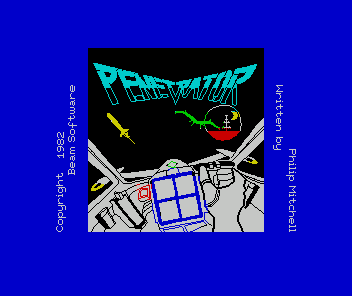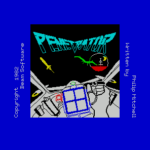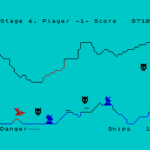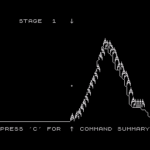
The tastefully named “Penetrator” was one of Beam Software’s earliest games. Designed for the ZX Spectrum by Philip Mitchell and Veronika Megler the game is a clone of Konami’s popular 1981 arcade game “Scramble”. A sideways scrolling shooter “Penetrator” recreates “Scramble”’s challenges of flying and shooting where the player navigates their ship through a treacherous landscape of mountains, skyscrapers and perilous caverns blowing up radar bases and dodging and destroying ground to air rockets to accomplish their mission to destroy an illegal cache of neutron bombs, then successfully fly back to base. Working with the limited memory of the ZX Spectrum the designers have created a worthy copy of the original with compelling gameplay, smooth scrolling and responsive controls using both the Spectrum keyboard or a Kempston Joystick.“Penetrator moves fast but the ship’s controls are sensitive enough to cope with firing and maneuvering at the same time. The sound, too, is surprisingly good in this version” explains Peter Conner in “Personal Computer Gamer” (Issue no 5, 1982) in his search for the definite “Scramble” clone. The game was praised also for the clarity and quality of it line based graphic and how each level is distinguished by their distinct design and colors.
The game was slightly less punishing than the arcade scrolling shooters like “Scramble” and “Defender” that required precision shooting, an arcade ploy designed to limit play times and swallow more coins. “Penetrator” however allowed for satisfying balance of the challenge between flying and shooting. The game featured a training facility that allowed players to skip between the levels without having to complete them so they could get a sense of the full game. It also included a level editor that Mitchell and Megler had originally created to assist them with the games design. It was a feature enjoyed by many players who used it to smooth out the difficult bits of the game and experiment with level designs of their own.
Veronika Megler discusses working on Penetrator with Philip Mitchell.
Another game that we wrote was Penetrator; Phil was the clear lead on that game while I worked on some pieces of it, and I think Kerryn* may have worked on it a bit too. It was a copy of the arcade game “Scramble”. Because of the speed (or lack thereof) of the processors at the time, we had to ensure that each separate path through the game took the same amount of time; even a difference of one “tstate” (processor state) between one path of an “if-then-else” to another would interfere with smooth motion, so we spent significant time calculating (by hand) the time taken by each path and choosing different Assembler instructions that would compensate for the differences (and given that “NO-op” took 2 tstates, it was not always easy). Another difficulty was getting the radars to turn smoothly, while handling the variable number of other activities taking place in the game. It took forever to get it “right”.
At the beginning we drew the screen bitmaps for all the landscapes on graph paper and then hand-calculated the hexadecimal representations of each byte for the screen buffer, but that became so tedious so quickly that Phil wrote an editor that we could use to create the landscapes. In the end the landscape editor was packaged with the game, as a feature.
Another “pressing” issue for shooter games of the time was that of keyboard debounce. At the time a computer keyboard consisted of an electrical grid, and when a key was pressed the corresponding horizontal and vertical lines would register a “high”. You checked the grid at regular intervals, and if any lines were registering high you used a map of the keyboard layout to identify the key that had been pressed. However, you had to stall for just the right amount of time before re-reading the keyboard; if you waited too long, the game seemed unresponsive, but if you read too quickly, you would read several key presses for each key press that the player intended. While it was possible to use the drivers that came with the keyboard, they did not respond quickly enough to use for interactive games. “Getting it right” was a tedious matter of spending hours fiddling with timings and testing.
From V.M. Megler, “There and Back Again: A Case History of Writing “The Hobbit”, Presented at Born Digital and Cultural Heritage Conference, ACMI, Melbourne, Australia, June 19-20 2014.© 2014 .
*Kerryn (surname unknown)was another Computer Science student from Melbourne University and friend of Megler and Mitchell’s who was working at Beam.
Version Information
A play in the browser version of Penetrator for the Spectrum is available on the Internet Archive as part of the ZX Spectrum Library: Games collection
Penetrator
A conversion to the Commodore 64 in 1984 by Bruce Bayley at Beam Software. There are no credits for graphics but Beam by this time had hired Russel Comte and Greg Holland to work with the expanded potential of the Commodore 64 for graphics. Adrian Pertout is credited for sound design. It also featured the editor.
Platform/s: Commodore 64
Developer: Bruce Bayley – Port
Penetrator
A licensed conversion was created for the Microbee by RWC in 1984 and distributed through Digital Concepts, Malvern, Victoria.
Platform/s: Microbee
Game Meta
Other Names
Additional Creators
Value Chain
Screenshots
- The title – written out gradually in a Turtle Graphics style.
- Main Menu
- Game Start
- In the thick of the action
- Training Run Level 2 has a different background
- Demonstration game finished. Let’s get…
- Fireworks when you succeed finishing the game
- Stage 1: The Return.
- Finishing Stage 2
- Stage 2. The Return.
- Stage 3. Beginning. I call it the oblique face. Pareidolia stuff ya know?.
- Stage 3. The danger line indicates the level of detection
- Stage 3. very complicated phase. Many, many spectrum keyboards down the toilet.
- Stage 3. The Return.
- Entering stage 4.
- Stage 4. New… aaa… Horace Vampire… things? (Defending paratroopers…)
- The Return: Stage 4.
- Stage 5 final momentum.
- Courtesy of Moby Games
- Stage 5. Time to turn the X-Wink axis.
- Bomb chute, hep’n’a-away…!!! IIaah!!!
- May the force… (ahamm) …may the power of the stars be with you Luk… (aaaam!) Loink, Flute, Blug!
- After blasting neutron bomb store.
- Back to base.
- The infamous impossible cave. So many many spectrum keyboar… (we already know!!!)
- The Game is over.
- Hall of Fame.
- CUSTOMIZING PENETRATOR instructions.
- This is my version of mount Fuji. Beautiful isn’t it?
- layer-made level for ease of high score.
- Commodore 64 Penetrator Title Page
- Commodore 64 Penetrator Game Play
- Commodore 64 Penetrator Game End
Box Art
- Penetrator Box Art. ZX Spectrum
- ZX Spectrum Cassette.
Media
- Full Page Ad
- Full Page Ad
Manuals & Walkthroughs
- Map of Penetrator.
Video









































